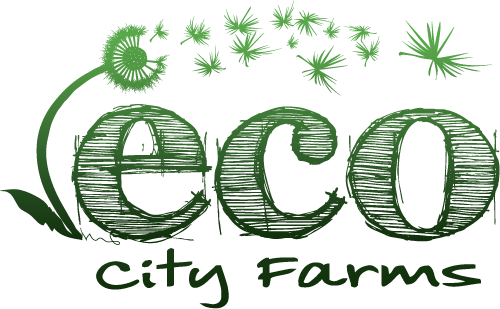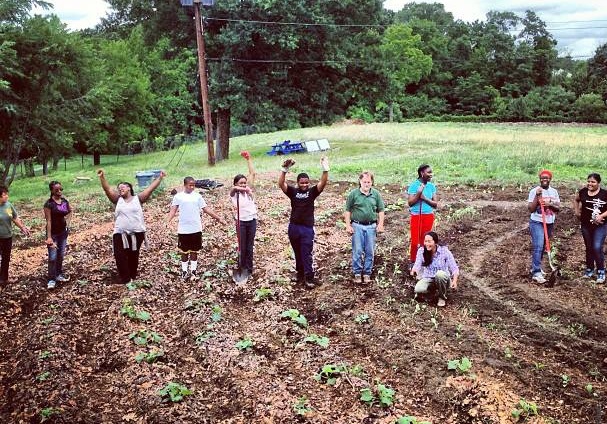A Day Out for the Summer Youth: Claggett Farm
On a hot and humid morning in late June, ten members of ECO City Farm’s Summer Youth Program climbed aboard a small bus to Claggett Farm in Upper Marlboro, Prince George’s County, Maryland.
For nearly two weeks, these young people had been experiencing first hand how vegetables grow, how they are prepared and cooked, and why they are worth eating. They had also been working hard at planting seedlings and pulling up weeds in the furrows of ECO City Farms’ newest project at the Autumn Woods apartment complex in Bladensburg.
Not surprisingly, the youth discovered – and sometimes complained about – how hard, hot and sweaty the work is to produce food.
ECO City Farms’ Summer Youth Program, called ‘Seed to Feed’, works with teenaged members of the Port Towns Youth Council run by End Time Harvest Ministries, and with the young people of the Magic Johnson Community Empowerment Center at Autumn Woods. ECO is a member of the Port Towns Community Health Partnership which advocates for healthy eating and active living as the keys to improved and sustained community health. The program aims to provide young people aged 13-15 who live and or study in the Port Towns of Bladensburg, Colmar Manor, Cottage City, and Edmonston with a fuller understanding of where food comes from, how it grows, how to cook and eat it, and how our food system works.
Throughout the six-week program, ECO staff aims to expand the young people’s ideas, comprehension and perceptions about themselves and what they put in their bodies and minds. They will learn about all aspects of the food system, and discover alternatives to the highly processed junk and fast foods that make up many families’ diets in Prince George’s County, where more than 70% of all adults are either obese or overweight. Each day of the Seed to Feed program is chock full new discoveries, ideas, and reflections, that include creative elements as well: the youth write reflections daily and participate in weekly poetry and photography sessions.
On the first day of the program, during a discussion led by ECO Community Educational Coordinator, Viviana Lindo, two young people reported that they had never tasted a cucumber. That day she worked with them to prepare their lunch, which included salad and homemade pasta and fruit salad, but some were hesitant to eat it. With giggles and telling gestures to one another, some politely picked at their plates. One young person who brought her own lunch and ate only her packaged Doritos, Lunchables and a red-dye colored drink – which couldn’t be more artificial than if we planned it. She eventually agreed to try the fruit salad, which she nominally tasted, without a lot of enthusiasm.
Watching the young peoples’ initial reactions, it is evident that for some, fresh herbs, fruit and vegetables are not in their regular diet, and the introduction of new flavors and unprocessed foods is a multi-step process. Giving a teenager a cucumber for the first time may not lead to love at first bite. However, it gives a starting point to new flavors to get used to and learn to like.
By the second week, the teens began warming more to all the new tastes. With occasional giggles and eye rolling, (“guacamole – yuck!”) some began to eat with more enthusiasm. And the young woman who previously picked at her fruit salad on the first day returned for seconds of fruit salad by the end of the second week. Inwardly, I smiled when I saw this.
By the time the group arrived at Claggett Farm, they had been introduced to a number of new concepts of food and farming. And yet, as the bus pulled into the farm’s long drive, and drove past green lush fields, there were gasps at how big the farm was, “Oh, get me back to the city!” quipped one young female. “This is so big – so scary,” remarked another.
Claggett Farm is a 270 acre nonprofit farm owned by the Chesapeake Bay Trust, which raises vegetables and cows on the wide rolling green fields of a former tobacco farm. Its barns are old, the land is rural, and it couldn’t get ‘farmier’ than this. As we arrived at the barn, one of the farmers roared by on a large tractor, which drew a few exclamations of surprise from our crowd. This was a whole different place from ECO’s small urban at Edmonston that they had become familiar with.
“Are you all ready to harvest garlic?!” the tractor driver asked enthusiastically, a farmer named Dave. I could feel the mood of the kids dampen like the humidity to find out that they were going to be working and not just touring the farm on this hot day. There was a low murmur of response.
As the prospect of work sank in, the farmer brought around a hay wagon, and the youth climbed aboard. As part of the curriculum, they were asked to prepare questions to ask the farmer, and they took the moment to ask: “What’s your favorite part of being a farmer?” “What will you do if farming doesn’t work out?” “Do you eat healthier now that you are a farmer?” All had great questions, and once again I was impressed by these youth.
 Enjoying the bumps as the tractor pulled off, the mood lightened despite the heat. The teens took photos and videos with their phones. As we arrived at the garlic field there was another round of moans – but eventually everyone got to work. With gloves on our hands and lined up beside a long row of garlic plants, we all began pulling up the bulbs just below the surface.
Enjoying the bumps as the tractor pulled off, the mood lightened despite the heat. The teens took photos and videos with their phones. As we arrived at the garlic field there was another round of moans – but eventually everyone got to work. With gloves on our hands and lined up beside a long row of garlic plants, we all began pulling up the bulbs just below the surface.
Starting slowly at first, (and with a fair amount of protest), the youngsters soon got the hang of it, pulling up a whole section and moving down the row. Most focused in on the work, finding the best way to pull up each bulb. In an hour, we harvested three full rows of garlic and brought it to the truck.
After lunch, it was back on the hayride, this time to learn about soil runoff and how the cows are grazed rotationally in the pastures. Claggett’s chief farmer, Michael Heller, showed the youth how the electric fences are moved daily to corral the cows from pasture to pasture. Though many did not want to get close to the cows at first, most showed great bravery and curiosity by following Farmer Mike down a small vale to see the beef cows and calves resting in the shade.
As a final task, they followed Farmer Mike across a field to help set up stakes and cording for the electric fence for the next day. Despite the ‘cow patties’ in the field, the prickly grass and buzzing insects, the teens were troopers and did the work.
 On the hayride back to the bus, the youth couldn’t resist smiling as we bumped along. This wasn’t so bad. They were getting used to the hay wagon. One young man sitting next to me, had a peaceful gaze as he looked up at the trees and stretched his hand out to the leaves of the passing tree branches. I recognized that look as the same as I have when I am in beautiful countryside. Though he kept his thoughts to himself, I could see the day had an impact. Back on the bus, they were clearly pleased to be back in air conditioning and heading home. Despite hearing more bellyaching (“I’m going to shower for hours!”, “I’ll stick to McDonald’s!”), I felt proud of these young people, as each day they are asked to move a bit more out of their comfort zones, and they have responded with effort and eventual joy of accomplishment.
On the hayride back to the bus, the youth couldn’t resist smiling as we bumped along. This wasn’t so bad. They were getting used to the hay wagon. One young man sitting next to me, had a peaceful gaze as he looked up at the trees and stretched his hand out to the leaves of the passing tree branches. I recognized that look as the same as I have when I am in beautiful countryside. Though he kept his thoughts to himself, I could see the day had an impact. Back on the bus, they were clearly pleased to be back in air conditioning and heading home. Despite hearing more bellyaching (“I’m going to shower for hours!”, “I’ll stick to McDonald’s!”), I felt proud of these young people, as each day they are asked to move a bit more out of their comfort zones, and they have responded with effort and eventual joy of accomplishment.
It’s clear that we are on a journey here with the young people of the Summer Youth Program, one that is a privilege to watch and wonderful to be part of. I look forward to more surprises in the weeks to come.











